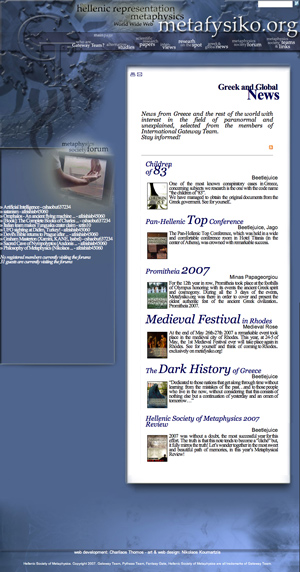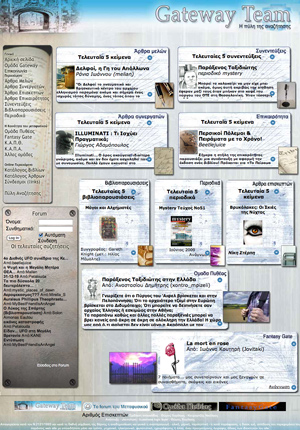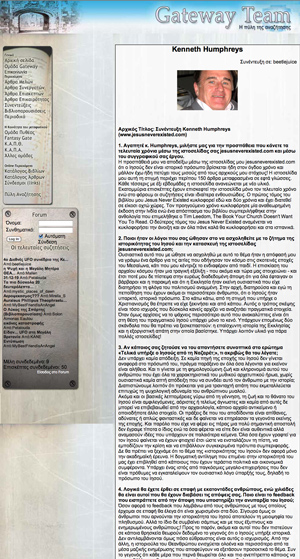Q and A
Interview with Metafysiko, Greece
February 2008
The “Jesus Never Existed” project is currently in its eighth year – perhaps half way towards completion! The web site now encompasses about 150 articles, with translations in seven languages. New material is added every four to six weeks. The site had over a million visitors in the last year alone and also has a lively forum following.
The first volume of the printed edition has been available for two years and has shipped to twenty-eight countries. An abridged edition was published last year in India and also an extract appeared in the anthology The Book Your Church Doesn’t Want You to Read edited by Tim Leedom. The second volume of Jesus Never Existed should be available this spring, and hopefully a Spanish edition.
Actually, the precursor of the whole study was a decision to write an article on the causes of the Dark Age, something that had interested me from a child. The eclipse of the ancient world was such a tragedy – it still casts its haunting shadow today – and I didn’t buy the conventional wisdom that it was all due to barbarians and decadence and that the church had kept the “flickering candle of civilization” alive.
At that stage, I held the same reasoning that most people still hold, “There was probably a Jesus.” After all, Christianity was real enough and it had to begin somewhere. That rationale holds up so long as you don’t go looking for evidence. When you do, you don’t find a historical Jesus, you find a void. So in fact there are two scandals that demand exposure: the despicable history of the Church and the outrageous fraud on which it is based. More than enough material for several web sites!
No evidence. No contemporaneous report in any source whatsoever. Impossible if any of the claims about him were true. And a purported life and legacy drawn entirely from mythic hero archetypes, with no residue of secular information to tie the guy into real history? It’s a palpable fraud that succeeds only because it taps into a psychological weakness in the human mind.
If you allow a few more words:
Basic details relating to Jesus’ birth, life and death are ambiguous, vague or completely unknown and not a word of it is confirmed by archaeology, artifacts or other evidence. Actions ascribed to him are unlikely, impossible or simply fantastical and had no discernible consequence on contemporaneous events. Despite the paramount importance of his mission Jesus wrote nothing himself and his reported words are not original but are regurgitations of earlier texts. Writings about Jesus are formulaic and are expressly designed to inculcate faith, suspend normal judgments, and reinforce behavioral norms.
We should never forget that the issue of a “historical Jesus” is not merely an academic enquiry. The dogmatic insistence on his historicity is an imperative of vast and powerful vested interests, a matrix of global mega-businesses that will never willingly give up their raison d’etre.
In terms of responses I’d say pros and cons are pretty much 50-50. But “Jesus deniers” are certainly a minority of the population. But then so are intelligent, informed people!
At present, even among the non-religious, the notion of a historical Jesus still holds the position of “default”. Most people have no idea how weak is that contention. On the other hand, the god-man fairy tale gets reinforced continuously in our culture, with the mainstream media ducking serious examination of the issue. Plus the fact, of course, it daily becomes more unacceptable to “offend” religious belief.
Ah, St Paul.
Well, in my opinion “St Paul the Apostle” is highly improbable. His pre-Christian life as a “persecutor” is wholly unconvincing and his alleged missionary journeys are bogus. Yes, we can grant that a handful of so-called epistles – perhaps as few as four – came from the pen of a headstrong religious bully, who may, possibly, have had the name Paul. Quite when they were written is problematic. The faithful like to place them in the 50s but they could well belong about a century later, just before Marcion collected and published them. Paul’s writings were both edited and supplemented by rival Jesus-factions during the second century and ultimately entered the canon of Catholic orthodoxy but they began life very differently, as gnostic tracts.
Curious, isn’t it, that the pioneering “Apostle to the Gentiles” actually addresses pre-existing religious communities everywhere he goes? I think the “foundational achievements” of Paul are a late, idealistic fantasy.
The path of “Jesus parallels” is well-trodden and, of course, meets with the predictable Christian response, “No, they copied from Jesus.” In part, I’m sure that’s true. The charlatan priests of Mithras were made from the same mould as the charlatan priests of Jesus and certainly would have copied “good stories” from their rivals just as readily. But what pulls the rug from under Christian apologetics is the testimony of the Church Fathers who candidly admitted “the devil” had got there first! And of course the pagan religions were hundreds of years older so it’s clear which way most of the copying went.
Examples? Almost all gods and heroes had miraculous births. That much was a given for any god-man. The most ancient example is probably Egypt’s Horus, who of course as an infant had to hide from his murderous rival Seth. Rome’s Romulus and Remus were sired by the god Mars from a Vestal virgin and this motif of “divinity from virginity” repeats itself with Hercules, Adonis, Tammuz, etc.
As heavenly counterparts of earthly kings, gods and godmen had to have a retinue of followers – recipients of their wisdom and witnesses to their miraculous deeds. Mithras had his band of 12 followers, an entourage derived from the 12 constellations through which the sun-god journeyed, and with whom he shared a last sacred meal. Dionysius turned water into wine, a trick copied by his crafty priests. Apollonius and Buddha were both “wise sages” who handed on epithets of wisdom. In fact, from Buddhist sources we even have word-for-word correlations of “Jesus speak”. Sayings and “mighty deeds” not plagiarized from pagan sources were simply redactions of Jewish scripture.
Christians don’t necessarily deny the connection but they can swallow this wholesale as “fulfillment of scripture”. To anyone else, it’s copying a good yarn.
OK, a brief answer.
Constantine was a ruthlessly ambitious prince, passed over in the orderly and merit-based system of succession established by Diocletian. Beginning with a rebellion on the fringes of the empire (in Britain) he set his sights on re-establishing an autocracy. Having spent time in the east, he knew that his imperial rivals had considerable trouble with disaffected Christians. So Constantine shrewdly declared himself their protector. It cost him nothing and rewarded him with the support of determined fanatics. He continued to tolerate the traditional gods but the Church gave him something the pagan cults could not – a disciplined hierarchy extending down from the imperial court to the provincial cities and major towns. A generation later, Theodosius introduced compulsion into religious belief and this signaled the final ruin of paganism.
Thanks largely to the chance discoveries of the Dead Sea Scrolls and the Nag Hammadi gospels we now have a much clearer understanding of both the diversity of early Christianity and the Jewish milieu from which it arose.
The creation of “Jesus lore” was an entire literary genre during the 2nd and 3rd centuries. But to meet the requirements of a “unifying” state religion (and, importantly, one that cloaked the imperial despot with an aura of “sacredness”) dogmas had to be agreed, codified and enforced. The elevation of Jesus to the “same essence” as God, and Mary as the “Mother of God” were the most scandalous achievements of the councils. Hence the rise of “creeds” and the wholesale destruction of heterogenous opinion.
With Christianity’s adoption as the favoured religion of the state, almost limitless funds became available for retro-fitting a “historical Jesus” within the Palestinian landscape, a necessary visual propaganda for an illiterate population. The most notable examples, of course, were the “Holy Sepulchre” and “Calvary” in Jerusalem, the “cave of the Holy Family” at Nazareth and the “cave of the nativity” at Bethlehem – complete with the True Cross, the true nails, Mary’s birthing garments, Jesus’ foreskin, even straw from the manger. Fabrication, thereafter, was more about establishing the pedigree of bishops as true successors and appointees of the apostles and that meant the invention of saints and relics wholesale.
The Reformation broke the spell of Catholic totalitarianism. Once the Pope was denounced as the Antichrist no part of the fabric of religion was secure.
Early interest centred on “recovering the gospel truth”, free of the embellishments and fabrications of Catholicism. Epistles which served papal aggrandizement were the first to be ditched, then passages within the gospels themselves that disguised insertions from a later age. Every identified forgery weakened further what remained.
Inescapably it was realized that the gospels were not four independent “witnesses” but were a single chain of story telling and that recognition focused attention towards recovering the original “true” story. But the process of deconstruction had – and has – no stopping point because there is no historical core. Only one thing stops every investigator reaching the same point – his faith – which at a certain stage arbitrarily concludes what “must be true”.
Pointing out that the emperor has no clothes has never been a healthy occupation. In earlier centuries, many died for their candour; many others blighted their careers for their honesty. But under the hammer blows of science and rationality traditional Christianity has dissolved into a dilute, individualistic, liberal humanitarianism, in terminal decline.
But that’s only half the picture. If you want to make money out of Jesus cut a deal with Apologetics, the US-driven merger of “sales technology” and junk history. The new crusaders from the bible-belt are the Jesuits reborn. They have resurrected the corpse of mediaeval Catholicism – biblical inerrancy, creationism, the global struggle of good and evil, salvation through the Church – and shamelessly use all the devices and technologies of science to sell a primitive and barbarous superstition.
The academic community has given a hostage to fortune by its very reasonableness and Politically Correct sensitivity to “faith”.
The prevalent view among scholars – even atheist scholars, it should be said – is that there was “probably” a Jesus. The notion is eminently reasonable. The name was commonplace. We know there were rebels of many different persuasions among the Jews in the 1st century. Augustus, Herod, Pilate, Caiaphas were certainly historical figures and we know Christianity emerged as a distinct religion during the 2nd century. Therefore, one can grant an existence to a “minimalistic” Jesus – sans virgin birth and other miracles – on the basis of reasonableness and commonsense.
The problem is that a generic Jesus is not any particular Jesus and is certainly not THE Jesus. In a population of about half a million Jews, the number of 1st century Jesuses would have been several thousands (perhaps as many as twenty thousand!). Four of the high priests in the 1st century were called Jesus; St Paul confronts a magician called Jesus and has an acolyte called Jesus; Josephus mentions nineteen characters with that name. We might suppose that any one out of this vast reservoir of Jesuses was our man but it would be an arbitrary choice with absolutely no historical support.
In reality, a generic Jesus is nothing more than a “G I Joe” or a “John Doe”. Without a tie into the historical record the Jesus tale is indistinguishable from a fairy tale – and that’s precisely what it is.
And yes, there are academics still chopping down the beanstalk. To name names, Thomas Thompson, Bob Price and Jay Raskin are among “accredited” scholars to declare the emperor has no clothes.
OK, fine. But if this is intended as a step towards honesty let’s at least complete the move and acknowledge that if Jesus never existed then “his” teaching is not “his” at all but is a cultural legacy from an earlier age, which may or may not be relevant today.
Do we really want to follow Jesus’ advice to cure sickness with exorcism?
Do we really want children to be told they were sinners from birth and that they risk the fires of hell?
Or that they should “take no thought of the morrow”, handle snakes and drink poison “with no harm”?
Too many people far too glibly assume Jesus’ purported pronouncements are the essence of goodness – which they most certainly are not. And quite honestly I think the classic notions of “cheek turning” and “loving enemies” are utterly impractical and woefully mistaken in principle.
I think Christianism will fall apart in the future but endless factionalism is the essence of religiosity because it is a man-made construct. But the parasite is also endlessly adaptable. Religion draws into itself the lost, the lonely, the unfulfilled. For that reason it will always be with us.
I think we will see a new Gnosticism emerge from “enlightened” Christianity (which has no need of a historical Jesus) and a militant Fundamentalism, hell-bent on realizing the apocalypse and its own “rapture”.
But I remain optimistic. Let’s hope we can keep most people on the side of rationalism and science.
Spirituality? There is a soullessness about a society that defines happiness as ever-greater consumption. That, of course, is the tragedy of America. Having gluttonously consumed the world it remains empty and tries to fill the void with Jesus.
For me, contentment flows from ever-greater understanding of the world and our place within it. It just so happens that knowledge is available at rock-bottom prices and minimal environmental impact! A secular society can create spectacle, art and “atmospheric” buildings better than any theocracy and if it’s awe and wonder people seek then the real universe has more mysteries than we can ever imagine.
Kenneth Humphreys



